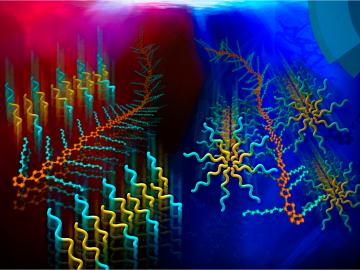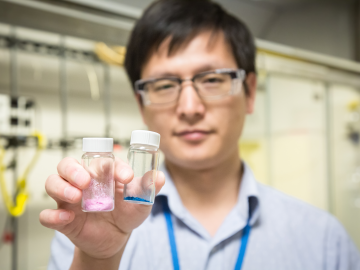Filter News
Area of Research
- (-) Biology and Environment (177)
- (-) Materials for Computing (36)
- (-) Neutron Science (190)
- Advanced Manufacturing (34)
- Biological Systems (18)
- Biology and Soft Matter (5)
- Building Technologies (12)
- Chemical and Engineering Materials (4)
- Chemistry and Physics at Interfaces (11)
- Clean Energy (522)
- Climate and Environmental Systems (14)
- Computational Biology (6)
- Computational Chemistry (5)
- Computational Engineering (5)
- Computer Science (19)
- Data (1)
- Earth Sciences (1)
- Electricity and Smart Grid (3)
- Energy Frontier Research Centers (14)
- Energy Sciences (5)
- Fossil Energy (3)
- Fuel Cycle Science and Technology (3)
- Functional Materials for Energy (16)
- Fusion and Fission (54)
- Fusion Energy (17)
- Geographic Information Science and Technology (3)
- Isotope Development and Production (3)
- Isotopes (35)
- Materials (433)
- Materials Characterization (2)
- Materials Synthesis from Atoms to Systems (13)
- Materials Under Extremes (12)
- Mathematics (1)
- National Security (79)
- Neutron Data Analysis and Visualization (4)
- Nuclear Science and Technology (74)
- Nuclear Systems Modeling, Simulation and Validation (3)
- Nuclear Systems Technology (1)
- Quantum Condensed Matter (4)
- Quantum information Science (9)
- Reactor Technology (1)
- Renewable Energy (4)
- Sensors and Controls (5)
- Supercomputing (311)
- Transportation Systems (11)
News Type
News Topics
- 3-D Printing/Advanced Manufacturing (19)
- Advanced Reactors (2)
- Artificial Intelligence (14)
- Big Data (10)
- Bioenergy (50)
- Biology (75)
- Biomedical (28)
- Biotechnology (13)
- Buildings (2)
- Chemical Sciences (17)
- Clean Water (13)
- Climate Change (41)
- Composites (6)
- Computer Science (35)
- Coronavirus (21)
- Critical Materials (1)
- Cybersecurity (1)
- Decarbonization (21)
- Energy Storage (17)
- Environment (98)
- Exascale Computing (4)
- Fossil Energy (1)
- Frontier (4)
- Fusion (1)
- Grid (3)
- High-Performance Computing (22)
- Hydropower (8)
- Isotopes (3)
- Machine Learning (10)
- Materials (35)
- Materials Science (40)
- Mathematics (3)
- Mercury (7)
- Microscopy (17)
- Molten Salt (1)
- Nanotechnology (24)
- National Security (6)
- Net Zero (2)
- Neutron Science (101)
- Nuclear Energy (4)
- Partnerships (5)
- Physics (11)
- Polymers (9)
- Quantum Computing (1)
- Quantum Science (9)
- Renewable Energy (1)
- Security (4)
- Simulation (14)
- Space Exploration (3)
- Summit (15)
- Sustainable Energy (36)
- Transformational Challenge Reactor (1)
- Transportation (12)
Media Contacts

Plants and other biomass can be converted into a variety of renewable high-value products including carbon fibers, plastics, and liquid fuels such as ethanol and biodiesel that are beneficial for reducing petroleum use and vehicle emissions. Breaking down plants in order to release...

The efficiency of solar cells depends on precise engineering of polymers that assemble into films 1,000 times thinner than a human hair.
Today, formation of that polymer assembly requires solvents that can harm the environment, but scientists at the Department of En...

For early career researchers, a fellowship can be a valuable foot in the door, exposing them to the opportunity to gain experience in areas of science and technology of national importance.

Crude oil refinement can be an extremely costly chemical process. In an effort to reduce energy and cost demands, Oak Ridge National Laboratory researchers Anibal Ramirez-Cuesta and Stuart Campbell are collaborating with University of Nottingham (UK) researchers to develop metal-orga...

Groundbreaking work at two Department of Energy national laboratories has confirmed plutonium’s magnetism, which scientists have long theorized but have never been able to experimentally observe. The advances that enabled the discovery hold great pro...

For more than 50 years, scientists have debated what turns particular oxide insulators, in which electrons barely move, into metals, in which electrons flow freely.

Throw a rock through a window made of silica glass, and the brittle, insulating oxide pane shatters. But whack a golf ball with a club made of metallic glass—a resilient conductor that looks like metal—and the glass not only stays intact but also may drive the ball farther than conventional clubs. In light of this contrast, the nature of glass seems anything but clear.

Complex oxides have long tantalized the materials science community for their promise in next-generation energy and information technologies. Complex oxide crystals combine oxygen atoms with assorted metals to produce unusual and very desirable properties.

When Orlando Rios first started analyzing samples of carbon fibers made from a woody plant polymer known as lignin, he noticed something unusual. The material’s microstructure -- a mixture of perfectly spherical nanoscale crystallites distributed within a fibrous matrix -- looked almost too good to be true.

Researchers at the Department of Energy’s Oak Ridge National Laboratory got a surprise when they built a highly ordered lattice by layering thin films containing lanthanum, strontium, oxygen and iron. Although each layer had an intrinsically nonpolar (symmetric) distribution of electrical charges, the lattice had an asymmetric distribution of charges. The charge asymmetry creates an extra “switch” that brings new functionalities to materials when “flipped” by external stimuli such as electric fields or mechanical strain. This makes polar materials useful for devices such as sensors and actuators.




